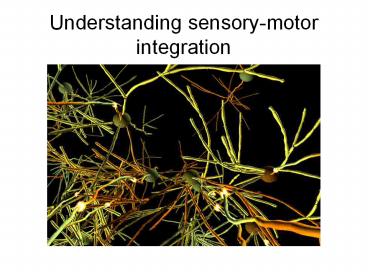Understanding sensory-motor integration - PowerPoint PPT Presentation
Title:
Understanding sensory-motor integration
Description:
Understanding sensory-motor integration * * * * * * * * * * * * * * * * * * * * * * * * * * It produces the serotonin derivative melatonin, a hormone that affects the ... – PowerPoint PPT presentation
Number of Views:810
Avg rating:3.0/5.0
Title: Understanding sensory-motor integration
1
Understanding sensory-motor integration
2
ORGANIZATION OF SENSORY SYSTEMS General
perspectives
- Sensori-motor integration
- External senses
- Localize/Detect and monitor change
- Less sensitive to unchanging stimuli
- Tunedsense modes
3
Organization of sensory systems
- Sense organs
- Receptors-specificity and transduction
- Receptive fields- and limitations
- coding- labeled lines vs pattern coding
- Adaptation and suppression
- Neural relays and recoding
- Intra-modality sensory Convergence
- Cortical representation/ perception
- Sensory subsystems
4
The Visual System
5
Tracing the ccts of vision
6
Organization of sensory systems
- Sense organs
- Receptors-specificity and transduction
- Receptive fields- and limitations
- Adaptation and suppression
- coding- labeled lines vs pattern coding
- Neural relays and recoding
- Intra-modality sensory Convergence
- Cortical representation/ perception
- Sensory subsystems
7
The organ of vision
8
The eye is like an SLR camera
9
Like a camera
- Lens-focus
- Iris-light control (aperture)
- Photoreceptors- transduction of light info
(Light sensitive film)
10
(No Transcript)
11
The lens-a small point of interest
12
Like a camera-lens is curved
- Upside-down and inverted
13
Like a camera- Control of eye movement also
critical
14
Eye movement- 3 major types of movement that can
affect vision
Pursuit/tracking Saccades vergence
15
Organization of sensory systems
- Sense organs
- Receptors-specificity and transduction
- Receptive fields- and limitations
- Adaptation and suppression
- coding- labeled lines vs pattern coding
- Intra-modality sensory Convergence
- Neural relays and recoding
- Cortical representation/ perception
- Sensory subsystems
16
Sensitivity and Limitations of the visual system
visible light spectrum
17
Organization of sensory systems
- Sense organs
- Receptors-specificity and transduction
- Receptive fields and limitations
- Adaptation and suppression
- coding- labeled lines vs pattern coding
- Intra-modality sensory Convergence
- Neural relays and recoding
- Sensory subsystems
- Cortical representation/ perception
18
The Iris
- Controls light exposure
19
Organization of sensory systems
- Sense organs
- Receptors-specificity and transduction
- Receptive fields- and limitations
- Adaptation and suppression
- coding- labeled lines vs pattern coding
- Intra-modality sensory Convergence
- Neural relays and recoding
- Sensory subsystems
- Cortical representation/ perception
20
The retina-photoreceptive tissue
21
Visual field and retino-topic organization
22
(No Transcript)
23
More on the retina
24
(No Transcript)
25
Photoreceptors
26
Rods and Cones
27
Receptive fields and Coding
RODS- dark/low illumination sensitive to
movement peripheral vision CONES- High
illumination sensitive to color foveal vision
28
ROD CONE DISTRIBUTION
29
FOVEA
30
FOVEA and optic disc/blind spot
31
Foveal acuity
32
Retinal circuitry
33
NOTE
- Light passes through ganglion cell layer, and
bipolar cell layer before striking photoreceptors
( light transparent). - Activation of photoreceptor activats cct in
reverse direction.
34
(No Transcript)
35
What accounts for Foveal acuity
36
Accounting for Foveal Accuity 1. Cone
properties 2. Circuitry
37
(No Transcript)
38
Color Coding in cones
39
(No Transcript)
40
The Trichromatic Theory of color
41
Receptive fields of Ganglion cells
42
Set up for sensory evoked recording
43
Sensory convergence
44
Retinal photoreceptors corresponding to Ganglion
cell receptive fields
45
(No Transcript)
46
Purpose of ganglion cell receptive fields?
47
Lateral inhibition?
48
Lateral inhibition
49
Overlapping receptive fields contribute to
lateral inhibition
The center of one field may be the surround of
another
50
Retina ganglion cell axons coalesce
51
and leave eye chamber to form the optic nerve
52
From retina to cortex
53
Decussation at optic chiasm
Decussation-crossing over ..how does this work?
54
Partial decussation at optic chiasm
Decussation-crossing over Not as simple as left
and right eye Decussation of visual field info
55
Temporal retina
Nasal Retina
56
-Nasal Retinal Fibers Cross-Temporal fibers do
not
57
(No Transcript)
58
(No Transcript)
59
(No Transcript)
60
(No Transcript)
61
(No Transcript)
62
(No Transcript)
63
Retinotopic-Cortical representation
64
-Left and right visual field info-upside
down-Foveal dominance
65
Cortical Organization- LGN input at layer 4
66
(No Transcript)
67
Vertical processing
68
Set up for sensory evoked recording
69
Remember sensory convergence
70
Receptive fields of neurons in the
PVC-orientation specificity
71
Orientation specificity
72
Orientation modulesSensory-evoked recording
studies
73
Modules- orientation specific columns plus PVC
blobs
74
Diagnosing/predicting visual deficits
75
What happens if the entire PVC is damaged?
76
Blind sight/ Superior Colliculi
- http//video.google.com/videosearch?hlenrlsGGIC
,GGIC2007-01,GGICeneiKD1bSsuNMJKKMe-c7EIresnu
m0qblindsightum1ieUTF-8saNtabwv
77
- Other visual subsystems
- -SCN
- -Pineal gland
78
Suprchiasmatic Nucleus-Circadian Rhythms
79
(No Transcript)
80
(No Transcript)
81
(No Transcript)
82
(No Transcript)
83
(No Transcript)
84
Pineal Gland-the third eye and Infradian rhythms
85
Secretor cells of the pineal gland
86
Produce melatonin
87
(No Transcript)
88
(No Transcript)
89
OK so what happens next?
90
VENTRAL STREAM
- Object Recognition
- Visual agnosias
- Prosopagnosia
- Anosagnosia
- http//video.google.com/videosearch?qramachandran
synesthesiawww_google_domainwww.google.comhle
nemb0aq4oqramachandranqramachandranimpost
erhlenemb0
91
prosopagnosia
92
- Dorsal Sream-
- WHERE/ CONTEXT/SPACE
- Balints
- Movement agnosia
- Visual Sensory neglect
93
Balints syndrome and Simultagnosia
- Balint's syndrome is a neuropsychological
disorder that results from damage to both
parietal lobes77. Clinically, it includes three
main symptoms simultanagnosia (the inability to
see more than one object at a time) optic ataxia
(the fixation of gaze with severe problems in
voluntarily moving fixation) and optic apraxia
(the inability to reach towards the correct
location of perceived objects)78 - Spatial-visual agnosia
94
Visual hemilateral neglect
95
Putting the Visual World into perspective The
DLPFC
96
(No Transcript)
97
Synesthesia and the DLPFC?
- http//science.discovery.com/videos/when-senses-co
llide-origins.html - Synesthesia
- Check it out Dawgs!
98
Sensori-Motor Integration































